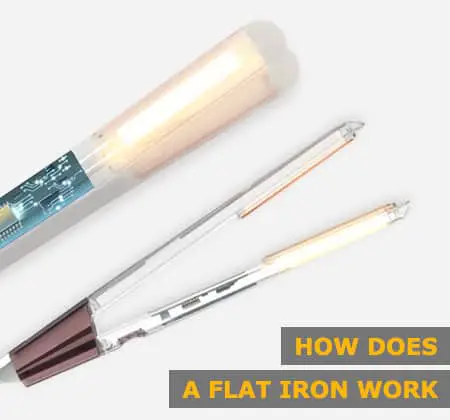
How does a flat iron work?
If you’ve ever wondered about the science behind this amazing hair straightening tool, you’re in luck!
Check out the complete answer!
Must-read: Top 5 flat irons To HAVE!
The Properties of Your Hair Is Important
Before we start off, you have to know quite a detail about your hair; the science behind it. Otherwise, the knowledge of the functions of a hair straightener will be of no use.
Hair is comprised of a protein known as keratin. Keratin is made out of long chains of amino acids.
Alongside hair, nails and teeth polish are likewise comprised of keratin. Hair, nails, and teeth share one significant factor for all intents and purposes that they are on the whole solid.
It is amazingly hard to break a strand of hair separated without a couple of scissors. No measure of bending, pulling, scouring, or notwithstanding pounding can do anything to hair.
The quality of hair can be ascribed to an uncommon property novel to proteins like keratin, which are comprised of an enormous number of sulfur-containing amino acids.
Sulfur molecules, from contiguous chains of keratin, bond together to frame disulfide bonds. These additional bonds make the strands that have keratin very strong.
Likewise, they guarantee that the situation of the keratin particles stays fixed, with the end goal that the state of the hair fiber remains the equivalent.
Changing the Shape of Hair; Making It Straight
Normally, this is a decent property since hair, particularly long hair is regularly exposed to a lot of pressure, and one would not need hair breaking or changing its shape due to this consistent mileage.
Nonetheless, when individuals would like to change the state of their hair like disposing of twists, including twists, making it wavy, making it straight, disulfide bonds that we mentioned above represent an incredible issue.
Most hair-rectifying methods, in this way, focus on these bonds.
A simple technique for breaking these bonds is utilizing heat. This carries us to what is likely the most widely recognized method for rectifying hair which is the flat iron.
How Hair Straighteners Work
How does a flat iron works? – The answer to this question cannot be clarified if we don’t know the the functions of any of these sections because these are what make a flat iron work ultimately.
The functions of a flat iron can be described from many perspectives because in general, a straightener goes through some scientific operations to make hair straight, on the other hand, there are 2 more features within a straightener that help to work it differently in different situations and more effectively.
Science Behind the General Operation

The plates of the iron are typically warmed to high temperatures, for the most part somewhere in the range of 148 and 260 degrees Celsius.
At the point when hair is gone through the iron rapidly, while being held tight and straight, the outrageous warmth causes the disulfide bonds to break.
This breakage permits the keratin chains to move around somewhat and accept a position that outcomes in fixed hair.
At the point when the hair chills off, the disulfide bonds between the keratin are changed. Since the keratin atoms are in various positions when the bonds are transformed, the hair remains in the fixed shape for an extensive stretch of time.
As the vast majorities who utilize flat irons know, this strategy for fixing hair is not perpetual. Introduction to moisture makes the hair return to its previous shape.
Role of Different Materials in Flat Irons
Now you know the general science of a flat iron.
But if you notice, you will see that there are few types of materials available that are frequently used in various flat irons of different brands.
The roles of these materials are very important behind flat iron’s activity to your hair because they moderate its functions very effectively.
- Ceramic coated straighteners get hot rapidly as a result of the metal plates underneath, yet they do not remain as hot as a genuine ceramic plate.
- Ceramic irons are phenomenal at holding heat. They get hot and remain hot; however, it does some of the time take them longer to warmth up. Since the plates on ceramic irons are so smooth, they are more averse to make tangles when pulling the straightener through your hair. They can make hair exceptionally straight and sparkling and should expel the greater part of the frizz when utilized at a suitable temperature. We love the Andis Multi heat ceramic hair straightener.
- Titanium is the best choice for coarse, thick, wavy hair due to how successfully it conducts heat. Titanium straighteners, in general, get more heated than ceramic ones, however dissimilar to less expensive metal plates, titanium delivers heat equally. Discover the best titanium hair straighteners we love!
- Tourmaline is a gemstone that produces negative ions, neutralizing the positive ions that reason frizz and waviness. Some tourmaline irons are ceramic coated. Tourmaline straighteners are perfect for wavy and fine hair surfaces. They heat up equitably, rapidly rectifying and sparkling.
Flat irons consist of different materials that work scientifically different.
Functions of Various Heat Settings

Straightener manufacturer brands include different heat settings in their products and give the users the power to control the operation. With these settings, people can save their hair from possible damage and use hair straighteners more advantageously.
There are generally 3 types of heat settings provided.
- Low heat setting: When you’re styling fine, prepared hair with temperature, 350°F or 175°C is a sure thing. Anything over 370°F/190°C is going to make great harm your hair.
- Medium heat setting: Except if your hair is outstandingly thick and difficult to style, and you do not damage the health of your hair strands, consistently keep your flat iron’s heat under 400°F/200°C.
- High heat setting: On the off chance that your hair is ultra-thick, curly, kinky, you need a great deal of heat to enter it. Begin by styling at 450°F/232°C. When you get your hair straightened with a flat iron, lessen the heat to 370°F/187°C.
Does Flat Iron Work for Good?
Early hair straightening frameworks depended on raspy synthetic substances that would in general harm the hair.
In 1909, Isaac K. Shero licensed the first-ever hair straightener made out of two-level irons that are heated and can be squeezed together which is the base of the modern flat irons.
But it was still harmful to hair as high heat temperature is not and never was good for the health of hair. But since then, scientists worked hard to develop flat iron as it earned huge popularity among the hair fashionistas; hair-conscious people.
Developers initially invented ways to include various advantageous materials and heat settings so that people can avoid hair damage and have their style done; straighten hair perfectly. So from this perspective, the modern flat iron is very good, reliable for hair straightening.
Verdict
Undoubtedly, the flat iron is one of the greatest inventions of modern science.
We tried to bring up the real science behind its functions, all way possible from our deep analysis. It is been 110 years since the base of the present flat iron was invented, and since then, the development of the flat iron did not stop for a while.
With the passage of time, it only gets better and better. It is very much fascinating how this thing works so smoothly and provides people amazing results by straightening their beautiful hair.
Sources
- Designs Authority, How Does A Hair Straightener Work? – ANSWERS To The History & Science Behind The Working of a Flat Iron
- About the Author
- Latest Posts
Writer and Content Manager at InStraight. Lovella’s philosophy is that everybody’s beauty is merely a reflection of loving yourself . ♀️ She loves to write and discover new cultures. Find her on Facebook

